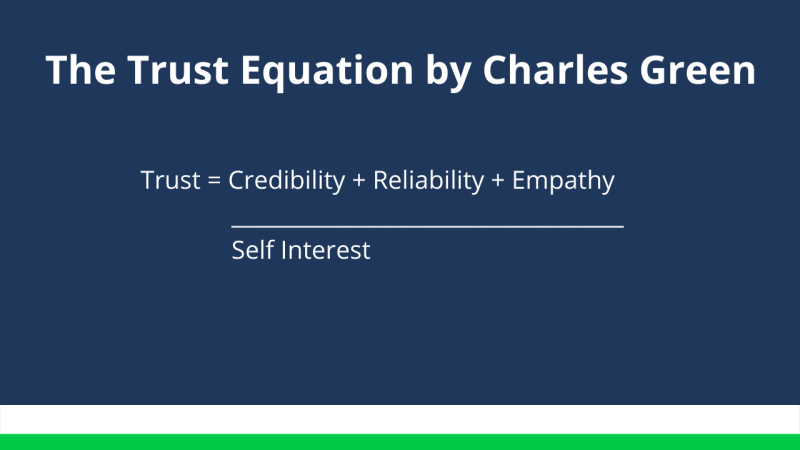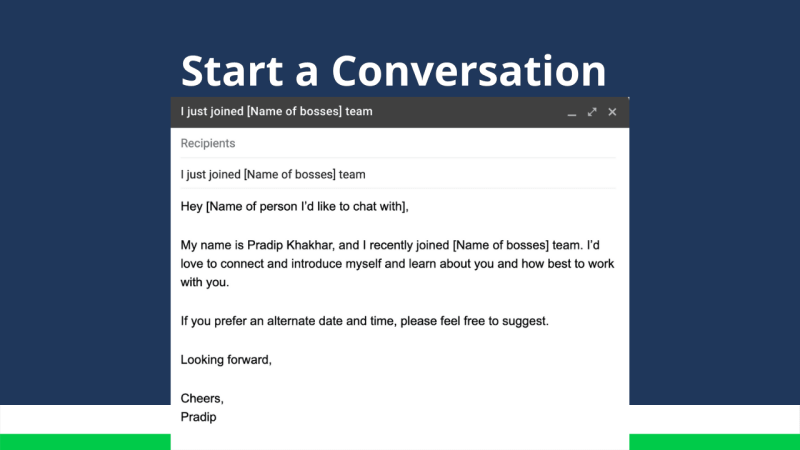30 Aug 2021
How to Develop Work Relationships and Start Conversations With Other Team Members
Communication, Relationships, and StakeholdersTo succeed as a product person you’ll need to develop your people skills, such as the ability to develop work relationships and start conversations with other team members.
Our role involves working in cross-functional teams. Some of the teams we work with include engineering, design, marketing, sales, and customer success.
Why develop work relationships?
One of the key factors that separate successful product people is the ability to create, cultivate, and develop successful exchanges.
Cross-functional teams with good work relationships can achieve more:
Positive impact on the team and opportunities for growth (reduces conflict)
Emotionally connected to the team and company (reduces attrition and increases loyalty)
Create a culture of employee wellbeing (increases happiness and engagement)
Building relationships at work
Building work or professional relationships takes time and consistently taking actions that are intentional.
When looking to build strong work or professional relationships consider the following:
Play the long game
Team discovery
Build trust
Give without the expectation of anything in return
Communicate with clarity and purpose
Play the long game
Do you remember that co-worker who reaches out only when they need something? Well, don’t be that co-worker.
Relationships are a two-way street. Above all, understand relationships will have periods of ups and downs. Successful relationships are built on mutual respect.
The power of compounding goodwill and giving people the benefit of the doubt can go a long way to building successful professional Interactions.
Team Discovery
At a macro level, provided that you and the other members of the cross-functional team are employed by the same company (not outsourced to an outside third party), there is already some inherent alignment in the team dynamics.
However, internal incentives are usually aligned differently for the product and members of the other team, so expect the possibility of some conflict.

Below are 5 things to consider when working to develop these relationships:
What/how they think
What motivates them
The biggest challenges they face
How they measure success
Clarify roles and reinforce
For example, some potential areas of misalignment with the sales team might include the sales team:
Pushing to close the deal without sight of the bigger picture
Oversharing or overpromising
Focuses on prospects that might not be a good fit
Some team members might only be brought in as and when required. That’s ok. In that case, bring up the topic as early as possible. For example, let’s say the sales team reaches out to request a modification to the company end of life/ end of support policy. The sales team indicated they need this modification to sign a new large logo.
You immediately know legal will need to be involved. The legal team can do their due diligence and make suggestions, however, ultimately it is a business decision.
Instead of waiting till everything is agreed on by the business unit, sales, and the prospect, involve the legal team early on. The legal team may have some suggestions for you to think about or they might just say let us know if the business agrees to it. Either way bringing in the legal team early is the right thing to do.
Build Trust
Work and professional relationships are based on trust. Trust is very hard to build, yet very easy to lose. Trust is a very difficult concept to define, think about:
In tough times who do you turn to?
Who are you most comfortable with?
Who will be there for you?
There is a lot of research out there on trust. In fact, Charles Green came up with a trust equation.

In The Decision to Trust by Dr. Robert F. Hurley, Dr. Hurley outlines the 10 essential elements of trust.
Three Trust Factors to Building Work Relationships
1. Risk Tolerance
How risk-averse a person is play’s into how trusting they are. Generally speaking, risk-takers do not focus on what could go wrong. People who are risk avoiders need assurances before trusting and may look to seek approvals before committing.
Do: Focus on small wins/ success, offer step-by-step explanations of any fear a team member has. Show empathy and understand their point of view.
Don��’t: Berate team members if they are not comfortable. Don’t ask team members to do something that you wouldn’t do.
2. Psychological Adjustment
Similar to risk tolerance, individuals’ ability to trust depends on how well adjusted they are. Well-adjusted individuals tend to be confident and are able to trust quickly. Whereas poorly adjusted (neuroticism) individuals tend to take longer.
Do: Show empathy and share additional assurances as needed when dealing with low adjustment individuals.
Don’t: Dismiss any concerns the team member has around discrimination, upbringing, or personal experiences. Don’t impose your values either.
3. Relative Power
An individual in a position of authority is more likely to be confident because they have the ability to punish the individuals who are subordinate.
Do: Focus on wins as a team. Building products is not a zero-sum game.
Don’t: Use your title or position of power to force a team member to do something they don’t want to or are uncomfortable with.
Seven Situational Factors to Building Work Relationships
1. Security
In general, the higher the stakes, the less likely individuals are likely to trust.
Do: Talk about how the risk can be managed and how to quickly recover if things don’t go the way you expected or anticipated.
Don’t: Make empty threats or promise huge wins.
2. Similarities
People can be tribal, meaning individuals are more likely to trust those who are similar to them.
Do: Focus on similarities, shared passions, and shared interests e.g. common groups, personality, background, education, interests, etc.
Don’t: Force your ideas of similarities on team members as a basis to do something.
3. Alignment of interests
At the end of the day, it’s not about you. What’s in it for the other person?
Do: Communicate interests clearly and with intent. Ask clarifying questions for understanding.
Don’t: Don’t make assumptions about interests.
4. Benevolent Concern
We are more likely to trust individuals who put our interests above their own.
Do: Listen with empathy and support the other person’s interests.
Don’t: *always* put your needs above your team members.
5. Capability
We are likely to trust someone who we feel is competent to get the job done.
Do: Share social proof of your capabilities and a can-do attitude.
Don’t: Lie about your capabilities.
6. Predictability and Integrity
Let’s say that a team member promises to be done wit a task by Monday. Unfortunately, if the same team member has a history of over-promising and under-delivering, the person receiving the completed task will apply what Dr. Hurley calls a “distrust discount” and assume the task will be delivered later than Monday.
Do: Do what you say, do it consistently.
Don’t: Only surface when you want something for your benefit.
7. Communication
Frequent, clear, and open communication leads to trusting relationships. Distrust can start to build with miscommunication.
Do: Share openly and frequently.
Don’t: Try to pass something in the fine print.
Give without the expectation of anything in return
This can be very difficult to understand. To be clear I am not saying go work for free by taking an unpaid job or unpaid internship. No, that’s a privilege and that is not where I want to go.
What I am saying is if you have an opportunity to help someone do it with the expectation of not expecting something in return.
For example, a team member needs the afternoon off work to attend to a personal situation and asks you to cover for them.
You agree.
Do not use this as an opportunity to guilt the individual to do something for you when you need it. If you do, you’ll very quickly lose the trust and respect of your team member.
Communicate with clarity and purpose
Communication is the transfer of information from one person to another. Another way to look at this is why should the person receiving the information care?
When the communication is clear it has a positive knock-on effect. Your cross-functional team understands information quickly but more importantly, the team understands the information accurately reducing misunderstandings.
Two of the common mistakes I have seen in communicating are:
Not tailoring the communication to your audience
Overloading people with unnecessary information
Start Conversations to build work relationships
Starting conversations is hard. I remember many times when I would do anything to not have to talk to anyone at work. Over the years I’ve gotten better thanks to amazing team members and friends.
Early in my career, I was fortunate enough to have a friend who worked at a company I wanted to work for. He helped guide me through the interview process, and I, fortunately, received an offer.
During the first week, I reached out to the same friend to get an understanding of the landscape who’s who, etc. During this call, he gave one piece of advice that has stuck with me since.
He said, “set up an introductory call with the immediate people you’ll work with.”
He also said some will accept some will pass. If they pass don’t feel bad, focus on ones that accepted.
To clarify in that role I was a remote employee with distributed team members hence the phone call. Remember not every interaction needs to be a video call. Phone calls while walking also works well.
I did my research and created a list of people I’d like to chat with. I started checking their calendars for availability and started to send out invites.
Email Template I used
Hey [Name of person I’d like to chat with],
My name is Pradip Khakhar and I recently joined [Name of bosses] team. I’d love to connect and introduce myself and learn about you and how best to work with you.
If you prefer an alternate date and time please feel free to suggest.
Looking forward,
Cheers,
Pradip

Before the call, I would research the person I’d be talking to with the intent to find shared interests. Google their name, check out their Linkedin profile, and company blog if there is one. This gave me a little insight into what articles they may have written or podcasts they have been on.
For example, working for an American company one VP also grew up in England. We immediately connected as a Brit living in the US. With another team member, we shared our love of the game of cricket.
This technique is not exclusive to when YOU join a new company. Use it when new team members join. Especially if you are likely to work with them.
The Result
When interacting with the team members I had the opportunity to chat with. I felt there was a deeper work relationship. We had started to build an understanding together.
Please note, a phone call will not solve all your work-related issues. However, it is a start to reducing friction.
Some team members may not reciprocate and that’s ok. Using the team discovery section above and learn more about how you can connect with them.
If you feel you can’t connect with some team members, try to understand why and accept that it’s ok.
Relationships are built over time. In my opinion, one of the key factors that separate successful product people is the ability to create, cultivate, and develop successful relationships.
The reality is successful products are built by successful cross-functional teams with good working relationships.
The Happy Hour
Building relationships at work should not be limited to when you join a new team or company or if a team member joins.
On a monthly or quarterly basis plan a team happy hour event. It can be something fun or an opportunity for the team to get together and chat on a personal level.

Pradip Khakhar

Read also
Experience the new way of doing product management






